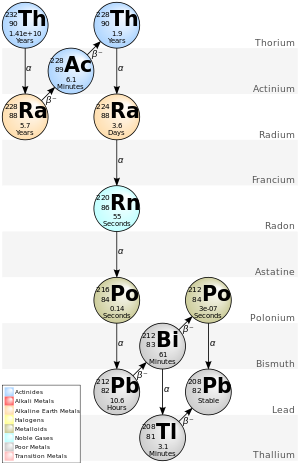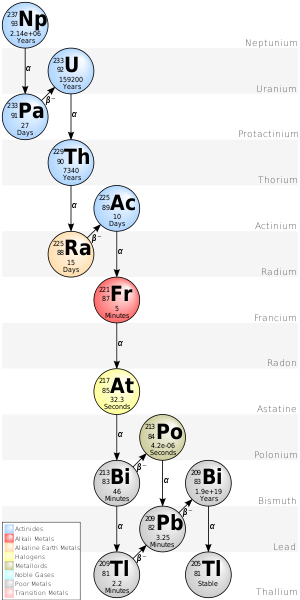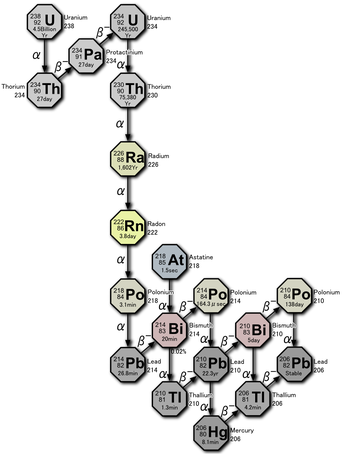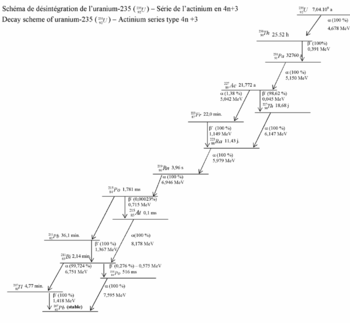- Decay chain
-
In nuclear science, the decay chain refers to the radioactive decay of different discrete radioactive decay products as a chained series of transformations. Most radioactive elements do not decay directly to a stable state, but rather undergo a series of decays until eventually a stable isotope is reached.
Decay stages are referred to by their relationship to previous or subsequent stages. A parent isotope is one that undergoes decay to form a daughter isotope. The daughter isotope may be stable or it may decay to form a daughter isotope of its own. The daughter of a daughter isotope is sometimes called a granddaughter isotope.
The time it takes for a single parent atom to decay to an atom of its daughter isotope can vary widely, not only for different parent-daughter chains, but also for identical pairings of parent and daughter isotopes. While the decay of a single atom occurs spontaneously, the decay of an initial population of identical atoms over time, t, follows a decaying exponential distribution, e−λt, where λ is called a decay constant. Because of this exponential nature, one of the properties of an isotope is its half-life, the time by which half of an initial number of identical parent radioisotopes have decayed to their daughters. Half-lives have been determined in laboratories for thousands of radioisotopes (or, radionuclides). These can range from nearly instantaneous to as much as 1019 years or more.
The intermediate stages often emit more radioactivity than the original radioisotope. When equilibrium is achieved, a granddaughter isotope is present in proportion to its half-life; but since its activity is inversely proportional to its half-life, any nuclide in the decay chain finally contributes as much as the head of the chain. For example, natural uranium is not significantly radioactive, but pitchblende, a uranium ore, is 13 times more radioactive because of the radium and other daughter isotopes it contains. Not only are unstable radium isotopes significant radioactivity emitters, but as the next stage in the decay chain they also generate radon, a heavy, inert, naturally occurring radioactive gas. Rock containing thorium and/or uranium (such as some granites) emits radon gas that can accumulate in enclosed places such as basements or underground mines. Radon exposure is considered the leading cause of lung cancer in non-smokers.[1]
Contents
Types
The four most common modes of radioactive decay are: alpha decay, beta decay, inverse beta decay (considered as both positron emission and electron capture), and isomeric transition. Of these decay processes, only alpha decay changes the atomic mass number (A) of the nucleus, and always decreases it by four. Because of this, almost any decay will result in a nucleus whose atomic mass number has the same residue mod 4, dividing all nuclides into four classes. The members of any possible decay chain must be drawn entirely from one of these classes. All four chains also produce helium-4 (alpha particles are helium-4 nuclei).
Three main decay chains (or families) are observed in nature, commonly called the thorium series, the radium series, and the actinium series, representing three of these four classes, and ending in three different, stable isotopes of lead. The mass number of every isotope in these chains can be represented as A = 4n, A = 4n + 2, and A = 4n + 3, respectively. The long-lived starting isotopes of these three isotopes, respectively thorium-232, uranium-238, and uranium-235, have existed since the formation of the earth. The plutonium isotopes plutonium-244 and plutonium-239 have also been found in trace amounts on earth.[2]
Due to the quite short half-life of its starting isotope neptunium-237 (2.14 million years), the fourth chain, the neptunium series with A = 4n + 1, is already extinct in nature, except for the final rate-limiting step, decay of bismuth-209. The ending isotope of this chain is now known to be thallium-205. Some older sources give the final isotope as bismuth-209, but it was recently discovered that it is radioactive, with a half-life of 1.9×1019 yr.
There are also many shorter chains, for example that of carbon-14. On Earth, most of the starting isotopes of these chains are generated by cosmic radiation.
Actinide alpha decay chains
Actinides Half-life Fission products 244Cm 241Pu f 250Cf 243Cmf 10–30 y 137Cs 90Sr 85Kr 232U f 238Pu f is for
fissile69–90 y 151Sm nc➔ 4n 249Cf f 242Amf 141–351 No fission product
has half-life 102
to 2×105 years241Am 251Cf f 431–898 240Pu 229Th 246Cm 243Am 5–7 ky 4n 245Cmf 250Cm 239Pu f 8–24 ky 233U f 230Th 231Pa 32–160 4n+1 234U 4n+3 211–290 99Tc 126Sn 79Se 248Cm 242Pu 340–373 Long-lived fission products 237Np 4n+2 1–2 My 93Zr 135Cs nc➔ 236U 4n+1 247Cmf 6–23 My 107Pd 129I 244Pu 80 My >7% >5% >1% >.1% 232Th 238U 235U f 0.7–12 Ty fission product yield In the four tables below, the minor branches of decay (with the branching ratio of less than 0.0001%) are omitted. The energy release includes the total kinetic energy of all the emitted particles (electrons, alpha particles, gamma quanta, neutrinos, Auger electrons and X-rays) and the recoil nucleus, assuming that the original nucleus was at rest. The letter 'a' represents a year.
In the tables below (except neptunium), the historic names of the naturally occurring nuclides are also given. These names were used at the time when the decay chains were first discovered and investigated. From these historical names one can locate the particular chain to which the nuclide belongs, and replace it with its modern name.
The three naturally-occurring actinide alpha decay chains given below—thorium, uranium/radium (from U-238), and actinium (from U-235)—each ends with its own specific lead isotope (Pb-208, Pb-206, and Pb-207 respectively). All these isotopes are stable and are also present in nature as primordial nuclides, but their excess amounts in comparison with lead-204 (which has only a primordial origin) can be used in the technique of uranium-lead dating to date rocks.
Thorium series
The 4n chain of Th-232 is commonly called the "thorium series." Beginning with naturally occurring thorium-232, this series includes the following elements: actinium, bismuth, lead, polonium, radium, and radon. All are present, at least transiently, in any natural thorium-containing sample, whether metal, compound, or mineral. The series terminates with lead-208.
nuclide historic name (short) historic name (long) decay mode half-life
(a=year)energy released, MeV product of decay 252Cf α 2.645 a 6.1181 248Cm 248Cm α 3.4×105 a 5.162 244Pu 244Pu α 8×107 a 4.589 240U 240U β− 14.1 h .39 240Np 240Np β− 1.032 h 2.2 240Pu 240Pu α 6561 a 5.1683 236U 236U α 2.3·107 a 4.494 232Th 232Th Th Thorium α 1.405·1010 a 4.081 228Ra 228Ra MsTh1 Mesothorium 1 β− 5.75 a 0.046 228Ac 228Ac MsTh2 Mesothorium 2 β− 6.25 h 2.124 228Th 228Th RdTh Radiothorium α 1.9116 a 5.520 224Ra 224Ra ThX Thorium X α 3.6319 d 5.789 220Rn 220Rn Tn Thoron,
Thorium Emanationα 55.6 s 6.404 216Po 216Po ThA Thorium A α 0.145 s 6.906 212Pb 212Pb ThB Thorium B β− 10.64 h 0.570 212Bi 212Bi ThC Thorium C β− 64.06%
α 35.94%60.55 min 2.252
6.208212Po
208Tl212Po ThC' Thorium C' α 299 ns 8.955 208Pb 208Tl ThC" Thorium C" β− 3.053 min 4.999 208Pb 208Pb ThD Thorium D stable . . Neptunium series
The 4n + 1 chain of Np-237 is commonly called the "neptunium series." In this series, only two of the elements are found naturally, bismuth and thallium. A smoke detector containing an americium-241 ionization chamber accumulates a significant amount of neptunium-237 as its americium decays; the following elements are also present in it, at least transiently, as decay products of the neptunium: actinium, astatine, bismuth, francium, lead, polonium, protactinium, radium, thallium, thorium, and uranium. Since this series was only studied more recently, its nuclides do not have historic names.
nuclide decay mode half-life
(a=year)energy released, MeV product of decay 249Cf α 351 a 5.813+.388 245Cm 245Cm α 8500 a 5.362+.175 241Pu 241Pu β− 14.4 a 0.021 241Am 241Am α 432.7 a 5.638 237Np 237Np α 2.14·106 a 4.959 233Pa 233Pa β− 27.0 d 0.571 233U 233U α 1.592·105 a 4.909 229Th 229Th α 7340 a 5.168 225Ra 225Ra β− 14.9 d 0.36 225Ac 225Ac α 10.0 d 5.935 221Fr 221Fr α 4.8 min 6.3 217At 217At α 32 ms 7.0 213Bi 213Bi β− 97.80%
α 2.20%46.5 min 1.423
5.87213Po
209Tl213Po α 3.72 μs 8.536 209Pb 209Tl β− 2.2 min 3.99 209Pb 209Pb β− 3.25 h 0.644 209Bi 209Bi α 1.9·1019 a 3.14 205Tl 205Tl . stable . . Radium series (also known as uranium series)
The 4n+2 chain of U-238 is commonly called the "radium series" (sometimes "uranium series"). Beginning with naturally occurring uranium-238, this series includes the following elements: astatine, bismuth, lead, polonium, protactinium, radium, radon, thallium, and thorium. All are present, at least transiently, in any natural uranium-containing sample, whether metal, compound, or mineral. The series terminates with lead-206.
nuclide historic name (short) historic name (long) decay mode half-life
(a=year)energy released, MeV product of decay 238U UI Uranium I α 4.468·109 a 4.270 234Th 234Th UX1 Uranium X1 β− 24.10 d 0.273 234mPa 234mPa UX2 Uranium X2,
Breviumβ− 99.84 %
IT 0.16 %1.16 min 2.271
0.074234U
234Pa234Pa UZ Uranium Z β− 6.70 h 2.197 234U 234U UII Uranium II α 245500 a 4.859 230Th 230Th Io Ionium α 75380 a 4.770 226Ra 226Ra Ra Radium α 1602 a 4.871 222Rn 222Rn Rn Radon,
Radium Emanationα 3.8235 d 5.590 218Po 218Po RaA Radium A α 99.98 %
β− 0.02 %3.10 min 6.115
0.265214Pb
218At218At α 99.90 %
β− 0.10 %1.5 s 6.874
2.883214Bi
218Rn218Rn α 35 ms 7.263 214Po 214Pb RaB Radium B β− 26.8 min 1.024 214Bi 214Bi RaC Radium C β− 99.98 %
α 0.02 %19.9 min 3.272
5.617214Po
210Tl214Po RaC' Radium C' α 0.1643 ms 7.883 210Pb 210Tl RaC" Radium C" β− 1.30 min 5.484 210Pb 210Pb RaD Radium D β− 22.3 a 0.064 210Bi 210Bi RaE Radium E β− 99.99987%
α 0.00013%5.013 d 1.426
5.982210Po
206Tl210Po RaF Radium F α 138.376 d 5.407 206Pb 206Tl RaE" Radium E" β− 4.199 min 1.533 206Pb 206Pb RaG Radium G - stable - - Actinium series
The 4n+3 chain of uranium-235 is commonly called the "actinium series". Beginning with the naturally-occurring isotope U-235, this decay series includes the following elements: Actinium, astatine, bismuth, francium, lead, polonium, protactinium, radium, radon, thallium, and thorium. All are present, at least transiently, in any sample containing uranium-235, whether metal, compound, ore, or mineral. This series terminates with the stable isotope lead-207.
nuclide historic name (short) historic name (long) decay mode half-life
(a=year)energy released, MeV product of decay 239Pu α 2.41·104 a 5.244 235U 235U AcU Actin Uranium α 7.04·108 a 4.678 231Th 231Th UY Uranium Y β− 25.52 h 0.391 231Pa 231Pa Protoactinium α 32760 a 5.150 227Ac 227Ac Ac Actinium β− 98.62%
α 1.38%21.772 a 0.045
5.042227Th
223Fr227Th RdAc Radioactinium α 18.68 d 6.147 223Ra 223Fr AcK Actinium K β− 99.994%
α 0.006%22.00 min 1.149
5.340223Ra
219At223Ra AcX Actinium X α 11.43 d 5.979 219Rn 219At α 97.00%
β− 3.00%56 s 6.275
1.700215Bi
219Rn219Rn An Actinon,
Actinium Emanationα 3.96 s 6.946 215Po 215Bi β− 7.6 min 2.250 215Po 215Po AcA Actinium A α 99.99977%
β− 0.00023%1.781 ms 7.527
0.715211Pb
215At215At α 0.1 ms 8.178 211Bi 211Pb AcB Actinium B β− 36.1 min 1.367 211Bi 211Bi AcC Actinium C α 99.724%
β− 0.276%2.14 min 6.751
0.575207Tl
211Po211Po AcC' Actinium C' α 516 ms 7.595 207Pb 207Tl AcC" Actinium C" β− 4.77 min 1.418 207Pb 207Pb AcD Actinium D . stable . . Beta decay chains in uranium & plutonium fission products
Since the heavy original nuclei always have a greater proportion of neutrons, the fission product nuclei almost always start out with a neutron/proton ratio significantly greater than what is stable for their mass range. Therefore they undergo multiple beta decays in succession, each converting a neutron to a proton. The first decays tend to have higher decay energy and shorter half-life. These last decays may have low decay energy and/or long half-life.
For example, uranium-235 has 92 protons and 143 neutrons. Fission takes one more neutron, then produces two or three more neutrons; assume that 92 protons and 142 neutrons are available for the two fission product nuclei. Suppose they have mass 99 with 39 protons and 60 neutrons (yttrium-99), and mass 135 with 53 protons and 82 neutrons (iodine-135), then the decay chains can be found in the tables below.
Nuclide Half-life 90Kr 32.32(9) s 90mRb 158(5) s 90Rb 5.84(2) s 90Sr 28.90(3) a 90mY 3.19(6) h 90Y 64.053(20) h 90m2Zr 131(4) ns 90m1Zr 809.2(20) ms 90Zr stable Nuclide Half-life 91Kr 8.57(4) s 91Rb 58.4(4) s 91Sr 9.63(5) h 91mY 49.71(4) min 91Y 58.51(6) d 91mZr 4.35(14) µs 91Zr stable Nuclide Half-life 92Kr 1.840(8) s 92Rb 4.492(20) s 92Sr 2.66(4) h 92Y 3.54(1) h 92Zr stable Nuclide Half-life 93Kr 1.286(10) s 93mRb 57(15) µs 93Rb 5.84(2) s 93Sr 7.423(24) min 93mY 820(40) ms 93Y 10.18(8) h 93Zr 1.53(10)E+6 a 93mNb 16.13(14) a 93Nb stable Nuclide Half-life 94Kr 210(4) ms 94Rb 2.702(5) s 94Sr 75.3(2) s 94Y 18.7(1) min 94Zr stable >1.1E+17 a 94mNb 6.263(4) min 94Nb 2.03(16)E+4 a 94Mo stable Nuclide Half-life 95Kr 114(3) ms 95Rb 377.5(8) ms 95Sr 23.90(14) s 95Y 10.3(1) min 95Zr 64.032(6) d 95mNb 3.61(3) d 95Nb 34.991(6) d 95Mo stable Nuclide Half-life 96Kr 80(7) ms 96mRb 200# ms [>1 ms] 96Rb 202.8(33) ms 96Sr 1.07(1) s 96mY 9.6(2) s 96Y 5.34(5) s 96Zr 20(4)E+18 a 96Nb 23.35(5) h 96Mo stable Nuclide Half-life 97Kr 63(4) ms 97Rb 169.9(7) ms 97m2Sr 255(10) ns 97m1Sr 170(10) ns 97Sr 429(5) ms 97m2Y 142(8) ms 97m1Y 1.17(3) s 97Y 3.75(3) s 97Zr 16.744(11) h 97mNb 52.7(18) s 97Nb 72.1(7) min 97Mo stable Nuclide Half-life 98Kr 46(8) ms 98mRb 96(3) ms 98Rb 114(5) ms 98Sr 0.653(2) s 98m4Y 0.83(10) µs 98m3Y 7.6(4) µs 98m2Y 2.0(2) s 98m1Y 620(80) ns 98Y 0.548(2) s 98Zr 30.7(4) s 98mNb 51.3(4) min 98Nb 2.86(6) s 98Mo stable [>100E+12 a] Nuclide Half-life 99Sr 0.269(1) s 99mY 8.6(8) µs 99Y 1.470(7) s 99Zr 2.1(1) s 99mNb 2.6(2) min 99Nb 15.0(2) s 99m2Mo 0.76(6) µs 99m1Mo 15.5(2) µs 99Mo 2.7489(6) d 99mTc 6.0058(12) h 99Tc 2.111(12)E+5 a 99Ru stable Nuclide Half-life 135Te 19.0(2) s 135I 6.57(2) h 135Xe 9.14(2) h 135Cs 2.3(3)E+6 a 135Ba stable Nuclide Half-life 137Te 2.49(5) s 137I 24.13(12) s 137Xe 3.818(13) min 137Cs 30.1671(13) a 137m2Ba 0.59(10) µs 137m1Ba 2.552(1) min 137Ba stable Nuclide Half-life 144Ba 11.5(2) s 144La 40.8(4) s 144Ce 284.91(5) d 144Pr 17.28(5) min 144Nd 2.29(16)E+15 a 144Pm 363(14) d 144Sm stable See also
- Nuclear science
- Radioactive decay
- Decay product
- Radioisotopes (Radionuclide)
Notes
- ^ http://www.epa.gov/radon/
- ^ D.C. Hoffman, F.O. Lawrence, J.L. Mewherter, F.M. Rourke (1971). "Detection of Plutonium-244 in Nature". Nature 234 (5325): 132–134. Bibcode 1971Natur.234..132H. doi:10.1038/234132a0.
References
- C.M. Lederer, J.M. Hollander, I. Perlman (1968). Table of Isotopes (6th ed.). New York: John Wiley & Sons.
External links
- Decay chains
- Government website listing isotopes and decay energies
- National Nuclear Data Center Freely available databases that can be used to check or construct decay chains. Fully referenced.
 The Live Chart of Nuclides - IAEA with decay chains, in Java or HTML
The Live Chart of Nuclides - IAEA with decay chains, in Java or HTML
Categories:- Radioactivity
Wikimedia Foundation. 2010.





